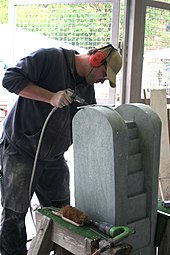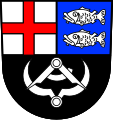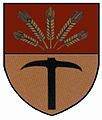Stonemasonry tool
Stone cutting tools are used by both stone masons and stone sculptors as so-called hand tools. Only the stone sculptors use a few other special chisels as well as measuring and transmission tools. The "chisels" call stonemasons and stone sculptors iron .
Stone working tools
For the most part, stonemason's tools are hand tools that have come down from history . The hand tools are divided into hard and soft stone tools according to their use .
The stone blocks extracted in the quarry used to be roughly worked. This processing is called bossing with the bossing hammer and bossing iron . In the work place were pieces of soft rock with cocked hat , the surface , the bush hammer , the impact of iron and Beizeisen , Krönel , Riffel Hammer and Stockhammer (with granite ) further fine machined and today (2008) still processed.
The tools of the stonemason and stone sculptor for processing the raw stone are either made entirely of tool steel or they have hard metals soldered into their cutting edges or tips, which are called widia irons . The tool equipment that stonemasons and stone sculptors use for manual surface and profile work are called "dishes".
Striking tools
The so-called irons are driven by the one-handed striking tools. There are the following striking tools, which are divided into one-handed and two-handed tools.
- One-handed tools that strike a second tool:
- Fäustel : Stonemasons call a hammer made of iron or steel with a weight of 1.0 to 1.5 kg.
- Lettering hammer: Hammer for hammering stone scripts with lettering irons , it is a lightweight hammer weighing less than 1 kg.
- Knüpfel : Knüpfel are cylindrical to hemispherical hammers made of wood (hornbeam), of plastic-coated, glued wood or of metal; they are used to drive the tools, especially in soft rock.
- Ambidextrous tools that hit another hammer or split the workpiece:
- Set hammer : It is a special form of a sledge hammer .
- Tools for direct processing of the surface:
- Stone ax (surface), tooth surface and crown are striking tools in the broadest sense.
- Stick hammer and ripple hammer are special forms of stone processing that enable special stone surfaces.
A special type of hand tool is the manual stone planer , which is rarely used for soft stone in France, but rarely in Germany.
Tools of the stonemasons and stone sculptors
- The stonemason's chisel hand tools are:
- Stone splitting tools ,
- Pickling iron ,
- Blasting iron (pitcher, prelleisen),
- Iron ,
- Pointed iron and the so-called dog tooth ,
- Tooth irons ,
- Bicorn ,
- Pointed surface ,
- Scharriereisen and
- Writing iron .
Irons driven with hammers are often slightly pointed or slimmer than the shaft or forged or ground. They have a so-called club head and recognize that they have to use the iron club. The iron driven by billets has a forged thickening, a billet head. The billet heads prevent excessive wear or damage to wooden billets. In addition to the standard forms of hand tools listed above, specially shaped irons are occasionally required for complicated profiles, such as round irons or inclined irons with rounded or inclined cutting edges or cranked irons. These irons are not commercially available and usually have to be forged as custom-made items or ground from widia irons.
Hand-held pneumatic and power tools
- Air hammers are used to hammer in writing or to create stone surfaces or profiles. The compressed air insert tools have shaped working tips and cutting edges like the hand tools. In principle, all work steps can also be carried out by hand with tools powered by compressed air, but the time required is usually greater. Certain work steps, such as the production of scratched surfaces, can only be carried out optimally by hand and with a chisel iron.
- Hand machines are used to make manual work easier and more effective. These are electric, pneumatic or oleohydraulic hand grinders and electric or pneumatic angle grinders , which are also called flex.
- Measuring tools and measuring aids used by stonemasons and stone sculptors are:
Special tools used by stone carvers
- Stone carving iron: In addition to the above mentioned stone sculptors need more special iron to carry out their filigree work.
- The tools for measuring or transferring models in stone sculptures by the stone sculptors are the puncturing device and the three-circle method with callipers , dividers or proportional angles .
Stone masonry tools in the town's coat of arms
Tooth surface and tooth iron (top right) in the coat of arms of Britten , Saarland
Pointed iron and hammer, hammer in the coat of arms of Laas , South Tyrol
Callipers and dividers as construction aids in the coat of arms of Weibern , Rhineland-Palatinate
general stonemason's mark in the coat of arms of Rieden , Rhineland-Palatinate
literature
- Vocational training center for the stonemason and stone sculptor trade (ed.): The work on stone (The stone mason and stone sculptor, Volume 2, Callwey, Munich 2003), ISBN 978-3-7667-1330-8
- Richard Thiele: Stone carving in architecture , Teubner, Leipzig 1956








